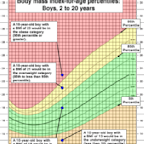Search results
Calculate Your Body Mass Index. Body mass index (BMI) is a measure of body fat based on height and weight that applies to adult men and women.
- The BMI Tables
BMI Calculator; Menu Plans; Portion Distortion; Key...
- Assessing Your Risk
Use the BMI Calculator or BMI Tables to estimate your body...
- Metric
Body mass index (BMI) is a measure of body fat based on...
- Increase Physical Activity
Increase Physical Activity Heart disease is the leading...
- Healthy Weight Tools
BMI Calculator. The BMI Calculator is an easy-to-use online...
- Recipes
Recipes. A variety of recipes is available to help you plan...
- Be Physically Active
Be Physically Active. Being physically active and eating...
- Know and Control Your Heart Health Numbers
Calculate your body mass index (BMI). BMI is an estimate of...
- The BMI Tables
- BMI Introduction
- BMI Table For Adults
- BMI Chart For Adults
- BMI Table For Children and Teens, Age 2-20
- Risks Associated with Being Overweight
- Risks Associated with Being Underweight
- Limitations of BMI
- BMI Formula
- BMI Prime
- Ponderal Index
BMI is a measurement of a person's leanness or corpulence based on their height and weight, and is intended to quantify tissue mass. It is widely used as a general indicator of whether a person has a healthy body weight for their height. Specifically, the value obtained from the calculation of BMI is used to categorize whether a person is underweig...
This is the World Health Organization's (WHO) recommended body weight based on BMI values for adults. It is used for both men and women, age 20 or older.
This is a graph of BMI categories based on the World Health Organization data. The dashed lines represent subdivisions within a major categorization.
The Centers for Disease Control and Prevention (CDC) recommends BMI categorization for children and teens between age 2 and 20.
Being overweight increases the risk of a number of serious diseases and health conditions. Below is a list of said risks, according to the Centers for Disease Control and Prevention (CDC): 1. High blood pressure 2. Higher levels of LDL cholesterol, which is widely considered "bad cholesterol," lower levels of HDL cholesterol, considered to be good ...
Being underweight has its own associated risks, listed below: 1. Malnutrition, vitamin deficiencies, anemia (lowered ability to carry blood vessels) 2. Osteoporosis, a disease that causes bone weakness, increasing the risk of breaking a bone 3. A decrease in immune function 4. Growth and development issues, particularly in children and teenagers 5....
Although BMI is a widely used and useful indicator of healthy body weight, it does have its limitations. BMI is only an estimate that cannot take body composition into account. Due to a wide variety of body types as well as distribution of muscle, bone mass, and fat, BMI should be considered along with other measurements rather than being used as t...
Below are the equations used for calculating BMI in the International System of Units (SI) and the US customary system (USC) using a 5'10", 160-pound individual as an example:
BMI prime is the ratio of a person's measured BMI to the upper limit of BMI that is considered "normal," by institutions such as the WHO and the CDC. Though it may differ in some countries, such as those in Asia, this upper limit, which will be referred to as BMIupper is 25 kg/m2. The BMI prime formula is: Since BMI prime is a ratio of two BMI valu...
The Ponderal Index (PI) is similar to BMI in that it measures the leanness or corpulence of a person based on their height and weight. The main difference between the PI and BMI is the cubing rather than squaring of the height in the formula (provided below). While BMI can be a useful tool when considering large populations, it is not reliable for ...
Sep 2, 2022 · Calculate your body mass index (BMI) and see the corresponding weight status category for adults 20 years and older. BMI is a screening measure for weight categories that may lead to health problems, such as underweight, overweight, or obesity.
Other articles from cdc.gov
Use this online BMI calculator to easily calculate your Body Mass Index (BMI) and get your BMI category, Prime index and health risks. Learn the formula, the history, the categories and the reliability of BMI calculations.
Calculate your body mass index (BMI) and waist-to-height ratio to assess your risk of weight-related health problems. Get tips on food, exercise, and metabolism to reach your healthy weight goal.
People also ask
How to measure your BMI Calculator?
What is the formula to calculate BMI?
How to create simple BMI calculater?
Jan 18, 2024 · Calculate your BMI and find out if you are underweight, normal, overweight, or obese. Learn how to use the BMI formula, what the BMI ranges mean, and how to adjust for muscle mass and age.








